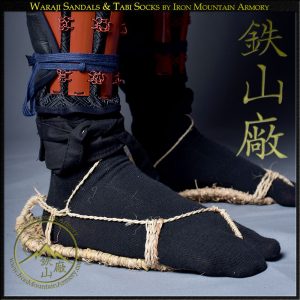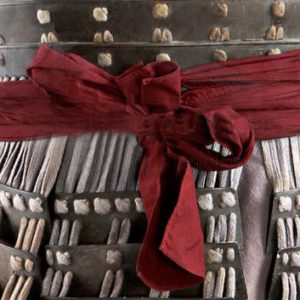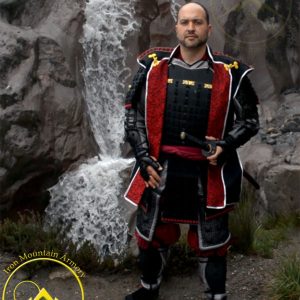- Traditionally Handcrafted
- Best Price Guarantee
- World wide delivery
$289.99 Original price was: $289.99.$194.95Current price is: $194.95. $194.95
Traditional Hitatare (samurai clothing) was the most common and iconic style of clothing worn by the Samurai from the Heian Period through Sengoku Era of Japan (796 – 1573). Our Traditional Hitatare consists of a hakama-shita (shirt for hakama) and a traditional kukui (tied) hakama. Iron Mountain Armory also includes the juban shitagi (undershirt), making it a full 3 piece set.
The traditional hakama-shita is open down the front and sides. Sleeves are attached only halfway down the body, are free flowing below, and have rope ties at the wrist. The sleeves can be tied up at the elbow when needed. The Hakama pants have soba (openings on the sides, along the top of the thigh). They have rope ties at the ankles giving them the option of being able to tie the pants at the knees while in the countryside or if worn with their armor. If pulled up, the samurai would likely haven worn kyahan (leggings) to protect their exposed skin or for added comfort under their suneate (shin armor). If the pant legs where down and tied at the ankle, the samurai would then wear the kyahan to hold the extra pant material in place, making the suneate more comfortable to wear.
The hitatare originated in early Heian Period and became a common samurai status clothing later during that same Period. Its large sleeves made it more impressive than what had been the standard for samurai previously. By the mid 13th century, the hitatare became the standard samurai outfit. Tall tate eboshi were typically worn with the hitatare up into the Kamakura Period (1185 – 1333); from the Muromachi Period onward, it became more common to wear folded, or flatter, ori eboshi with the hitatare. If wearing armor, the samurai would commonly wear a Yoroi Hitatare which differs slightly from the Traditional Hitatare. Our samurai clothing and accessories are featured in the docudrama “Age of Samurai: Battle for Japan” by Netflix & the Smithsonian Channel.
Ordering Options: When selecting Era Style: Sengoku / Muromachi or Edo era will provide you with fabric options which were more common during either era. When you Add a Mon to your order, you will be given the option to select between one of our standard mon options or to send us your own custom mon design. You can do this by replying to your order confirmation email with your mon and we will add it to your order details for you. If you select the Printed Mon option, we will select the style of print best suited for your order, which can be traditional or heat transfer sticker. This is because some material / colors work better with different printed methods.
Features: Our Traditional Hitatare is a 3 part set, which includes a hakam-shita, kukui-hakama and cotton juban shitagi (undershirt).
Custom measurements you provide are for reference only. Alterations may be made for a proper traditional fit as deemed necessary by our seamstress
[table id=235 /]
Accessories:
[table id=PF /]


